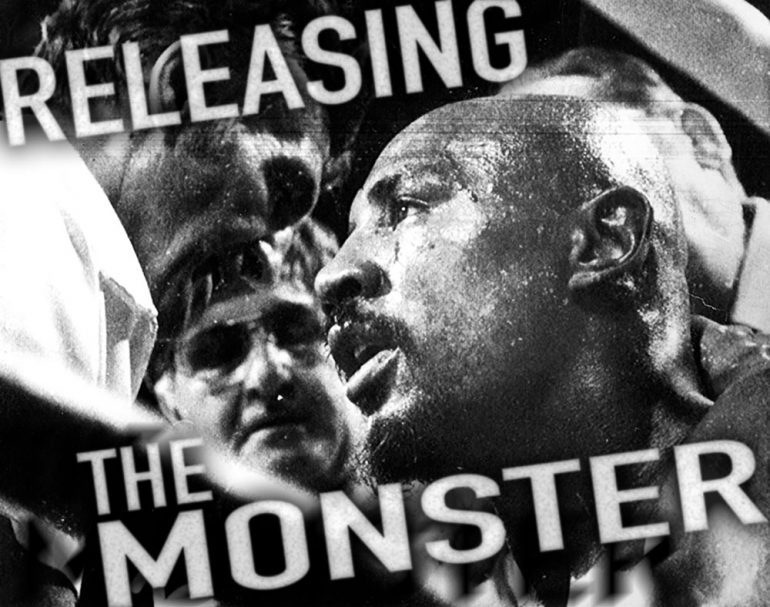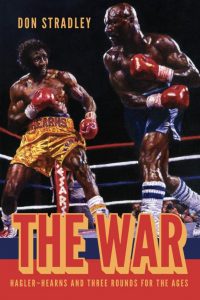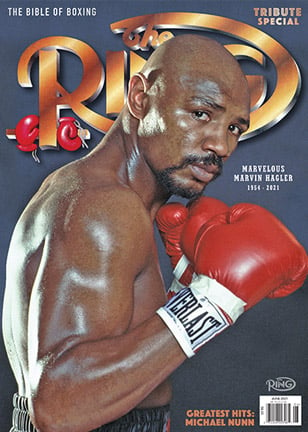
MARVIN HAGLER’S INTENSE PREPARATION FOR HIS SHOWDOWN WITH THOMAS HEARNS WAS AS MUCH MENTAL AS IT WAS PHYSICAL
The following is an excerpt from The War: Hagler-Hearns and Three Rounds for the Ages by Don Stradley (available September 2021 from Hamilcar Publications).
On Monday night, April 8, Marvelous Marvin Hagler arrived in Las Vegas. Welcomed to Caesars Palace by a parade of costumed Roman guards and princesses, he surveyed the crowd that surrounded him in the lobby and said, “I have come to destroy.”
In an interview conducted in his suite, Hagler told a small gathering of reporters that he didn’t want to train in the hotel facility because he’d feel like “a circus performer.” Wanting the rawness of a real boxing environment, he’d planned some private workouts at Tocco’s Ringside Gym, a dour cinderblock building five miles north of The Strip. Hagler told the press that he craved a dank, empty setting where he and the Petronellis could get their work done without interference. At Caesars, Hagler said, “every time you fart it winds up on television.”
Tocco’s gym on Charleston Boulevard was basically a shabby old storefront with an iron-grated fence. The owner, Johnny Tocco, was a longtime boxing operator who had been a promoter in St. Louis and had once been Sonny Liston’s manager. He’d worked the corner of fighters ranging from Willie Pep to Mike Weaver, and though he was in his seventies and in poor health, he remained a fixture of the Las Vegas fight scene. His gym, which had the ramshackle atmosphere seen in old 1940s boxing movies, was a favorite of fighters coming to Las Vegas. Tocco had once owned a bar, The Zebra Room, which had been adjacent to the space where fighters now trained. Tocco’s favorite joke: “I got so tired of breaking up fights, I figured I might as well be running a gym.”
Many journalists were surprised that millionaire boxers would bother with such a decrepit joint as Tocco’s. As Wallace Matthews recalled, “There was just about enough room for a boxing ring and a payphone.” The ring itself was wretched, its ropes held together by black electrical tape. “The ceiling,” reported the Miami News, “painted a hideous dark red, is pock-marked with holes, while the floor is a nightmare patchwork of blue, bright orange, brown, red and green carpet remnants.” The neighborhood alone was repugnant, seemingly made up of abandoned buildings and liquor stores; degenerates roamed the sidewalk drinking popskull. At least once every 10 years there was a fatal shooting or stabbing nearby, usually the result of robberies gone wrong. “This is one of those transient neighborhoods,” Tocco once said, explaining that he’d installed a special gate with a buzzer to keep the riffraff out. “The bus station is just around the corner. You get some of those bums around here, they haven’t had a bath for 30 days, they’re covered with blood, they walk in off the street and want to take a shower. Forget it. This way I let who I want into the place.”

Despite his star status, Hagler was at home in the rough confines of Johny Tocco’s gym. (Photo by Jim Wilson/The Boston Globe via Getty Images)
Hagler loved the isolation of Tocco’s and the unique aroma one reporter described as a mix of coffee grounds, dirty socks and sweat. It was a blast furnace, temperatures rising so high that the faded old fight posters seemed on the verge of melting into the walls. Regulars kidded that a fighter once put a raw chicken on a plate in the morning and placed it next to the ring; when Tocco closed for the night that piece of poultry was cooked. “When Marvin comes to train,” Tocco once said, “he stands outside that back door, shaking the bars, and yelling to me: ‘Warden! Warden! Let me in, warden!’”
Hagler liked Tocco’s because it reminded him of the early days in Brockton. “My life don’t change just ’cause I got successful,” he said. “You ain’t gonna see me out there like it’s a circus, showboating, putting on a show for everybody, acting real cute, looking at all the beautiful women around and showing off. You know what I mean.”
“Tocco’s wasn’t flashy, but it was good for us,” remembered Tony Petronelli. “We wanted to keep things quiet and get Marvin ready. It could be a little bit of a challenge to keep people away.”
Mike Bruton of the Philadelphia Inquirer was one of the few journalists allowed in. Like a field reporter relaying grim images from the war front, he described Bobby Watts wearing padding to protect his sore ribs from Hagler’s sledgehammer attack. Detroit columnist Mike Downey reported a visit to Tocco’s where Hagler and Watts sparred “as if the championship were at stake this very night.”
To Watts, though, Hagler was merely a fighter in training.

Months of buildup culminated in an eight-minute tear-up that will never be forgotten. (Photo b Jacques M. Chenet/CORBIS/Corbis via Getty Images)
“It was a great experience,” Watts recalled in 2020. “Later in my life I trained a lot of fighters, and I learned so much by watching the Petronellis work with Marvin Hagler. They had great teamwork. They were great guys. They made me feel at home and told me what they expected from me. You see, I was similar to Hearns in style. I was tall and slim, just like Hearns, and I moved like him. They used me so Marvin Hagler could get acclimated to that style.”
Though Watts had handed Hagler his first loss many years earlier and had been knocked out in a rematch, there were no bad feelings in the training sessions. “Marvin was mostly all business. In the morning when he showed up, he’d talk to you and stuff like that. But once we began training, he was all business,” Watts said.
Hagler loved the image being created, that Tocco’s was where he went to undergo a secret transformation. “The monster is coming over me again,” Hagler said, relishing the bare-bones atmosphere. “There was a time years ago when I thought I’d have to kill somebody for anyone to notice me. And Hearns thinks he can hurt me?”
Since Hagler didn’t go to Tocco’s until the early evening, he made himself available to reporters in the mornings. He provided them with a fresh new quote every day, usually along the lines of how he would beat Hearns without mercy and destroy his soul. “When I finish with Hearns, he’s never going to get his confidence back,” Hagler said. When told that Hearns was gaining traction at the betting windows, Hagler barked, “I hope they have him 10-1, so when I knock his shoes off they’ll know about it.”

(Photo by Jacques M. Chenet/CORBIS/Corbis via Getty Images)
“There was a time years ago when I thought I’d have to kill somebody for anyone to notice me. And Hearns thinks he can hurt me?”
– Marvelous Marvin Hagler
He talked about his future in commercial endorsements and his concern about Las Vegas judges, the ones who had given him poor scores in his bouts with Antuofermo and Duran. The question that reporters never tired of asking was whether he really hated Hearns.
“I have nothing personal against Thomas,” Hagler said. “I just don’t like him. What do you want me to do…kiss him?” Hagler explained how his feelings about Hearns were somewhat manufactured. “But I have to take those feelings into the ring with me,” he said. “If someone tries to take your job away, do you love them?”
 Perhaps the most revealing comment from Hagler was given to Phil Pepe of the New York Daily News. “My popularity is going to grow so much that I am going to lose my privacy,” Hagler said. According to Pepe, Hagler announced this “almost regretfully.”
Perhaps the most revealing comment from Hagler was given to Phil Pepe of the New York Daily News. “My popularity is going to grow so much that I am going to lose my privacy,” Hagler said. According to Pepe, Hagler announced this “almost regretfully.”
For now, though, Hagler was embracing the attention. He was especially happy when an ABC camera crew wanted to follow him on one of his morning runs across the Dunes Hotel golf course. As he chanted, “Destruct and destroy,” an automatic sprinkler gushed out of the ground and drenched him.
Being talkative in recent weeks had made Hagler the pet of press row. For the first time, he was entering a bout as the sentimental favorite. Most boxing reporters had for decades offered their fight coverage with a distinct hero versus villain slant. In this case, however, while Hagler was being depicted as the working-class hero, the villain wasn’t necessarily Hearns. It was society at large, and Howard Cosell and Ray Leonard, and boxing’s powerbrokers, and the press itself, and the networks, and the promoters, and the fickle fans, and boxing’s peculiar star system, and anyone who had ever kept Hagler from being appreciated. It was useful to overlook his status as the world’s best-paid athlete and maintain his hard-luck story. Hagler had told his tale of woe so effectively for so long that it had penetrated the minds of reporters and was bleeding out through their keyboards.
There was a moment earlier in the week where Hagler dropped his tough guy pose and answered a direct question with sincerity. What would happen if he lost?
“My kids would still call me ‘Daddy,’” he said. “My wife would still have a husband. The world ain’t going to end, you know…”
But Hagler knew that something in his life would be snuffed out if he were to lose. “This fight is the highlight of my entire career,” he said. Hagler claimed Hearns could lose and simply go back to being the junior middleweight titleholder, but the consequences of his own loss would be bleaker.
“If I lose,” Hagler said, “I have nothing.”


